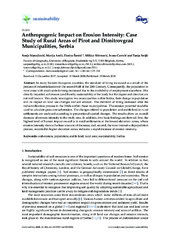Приказ основних података о документу
Anthropogenic Impact on Erosion Intensity: Case Study of Rural Areas of Pirot and Dimitrovgrad Municipalities, Serbia
| dc.creator | Manojlović, Sanja | |
| dc.creator | Antić, Marija | |
| dc.creator | Šantić, Danica | |
| dc.creator | Sibinović, Mikica | |
| dc.creator | Carević, Ivana | |
| dc.creator | Srejić, Tanja | |
| dc.date.accessioned | 2021-09-24T15:41:46Z | |
| dc.date.available | 2021-09-24T15:41:46Z | |
| dc.date.issued | 2018 | |
| dc.identifier.issn | 2071-1050 | |
| dc.identifier.uri | https://gery.gef.bg.ac.rs/handle/123456789/947 | |
| dc.description.abstract | In many Eastern European countries, the standard of living increased as a result of the process of industrialization in the second half of the 20th Century. Consequently, the population in rural areas with small-scale farming decreased due to the availability of employment elsewhere. This directly impacted soil erosion (and thereby sustainability of the land), but the degree and direction are not well known. This study investigates two municipalities within Serbia, their change in population and its impact on land use changes and soil erosion. The standard of living increased after the industrialization process in the 1960s within these municipalities. The erosion potential model is used to calculate gross annual erosion. The changes related to population and arable land in rural settlements are analyzed according to proportional spatial changes. The results show an overall decrease of erosion intensity in the study area. In addition, two basic findings are derived: first, the highest level of human impact on soil is in rural settlements at the lowest elevation zones, where erosion intensity shows the least amount of decrease; and, second, the most intensive depopulation process, recorded in higher elevation zones, indicates a rapid decrease of erosion intensity. | en |
| dc.publisher | Basel : MDPI | |
| dc.relation | info:eu-repo/grantAgreement/MESTD/Integrated and Interdisciplinary Research (IIR or III)/43007/RS// | |
| dc.relation | info:eu-repo/grantAgreement/MESTD/Integrated and Interdisciplinary Research (IIR or III)/43009/RS// | |
| dc.relation | info:eu-repo/grantAgreement/MESTD/Basic Research (BR or ON)/176017/RS// | |
| dc.rights | openAccess | |
| dc.rights.uri | https://creativecommons.org/licenses/by/4.0/ | |
| dc.source | Sustainability | |
| dc.subject | soil erosion | en |
| dc.subject | population | en |
| dc.subject | arable land | en |
| dc.subject | rural area | en |
| dc.subject | sustainability | en |
| dc.subject | Serbia | en |
| dc.title | Anthropogenic Impact on Erosion Intensity: Case Study of Rural Areas of Pirot and Dimitrovgrad Municipalities, Serbia | en |
| dc.type | article | |
| dc.rights.license | BY | |
| dcterms.abstract | Манојловић, Сања; Срејић, Тања; Царевић, Ивана; Сибиновић, Микица; Шантић, Даница; Aнтић, Марија; | |
| dc.citation.volume | 10 | |
| dc.citation.issue | 3 | |
| dc.citation.other | 10(3): - | |
| dc.citation.rank | M22 | |
| dc.identifier.wos | 000428567100253 | |
| dc.identifier.doi | 10.3390/su10030826 | |
| dc.identifier.scopus | 2-s2.0-85043982258 | |
| dc.identifier.fulltext | https://gery.gef.bg.ac.rs/bitstream/id/843/945.pdf | |
| dc.identifier.rcub | https://hdl.handle.net/21.15107/rcub_gery_947 | |
| dc.type.version | publishedVersion |


